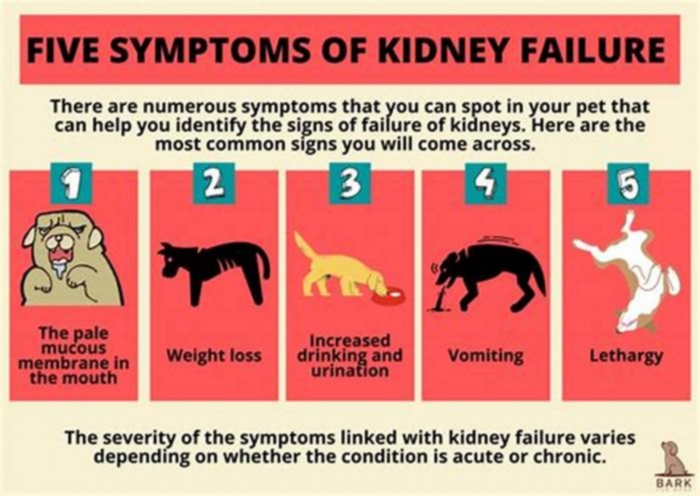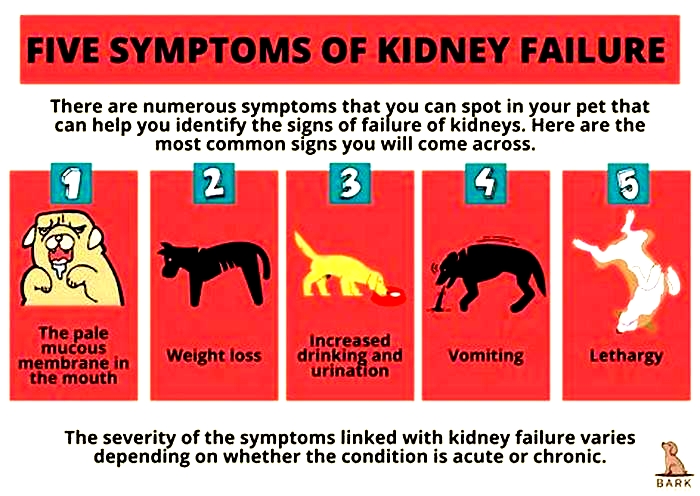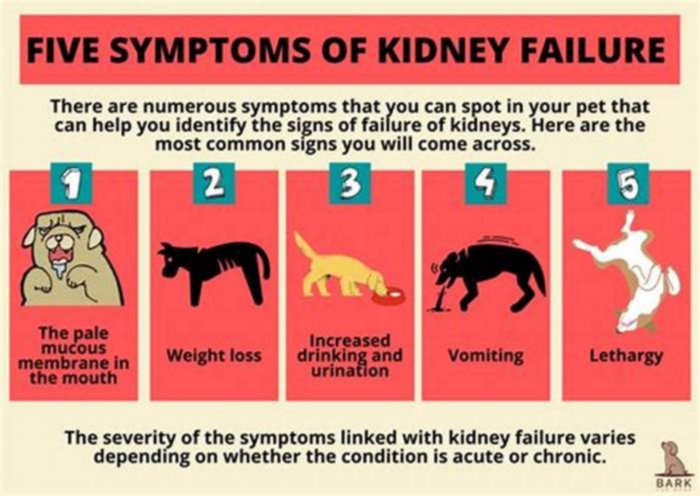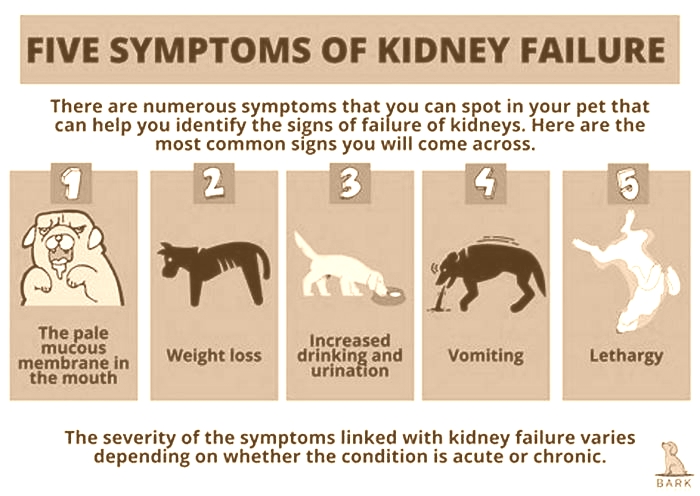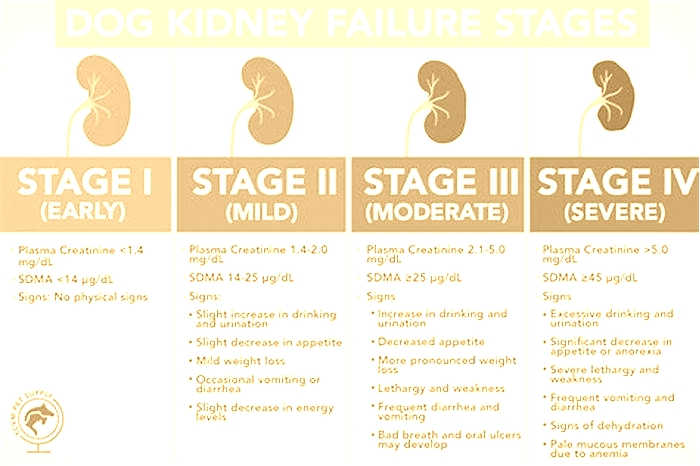kidney failure in dog causes
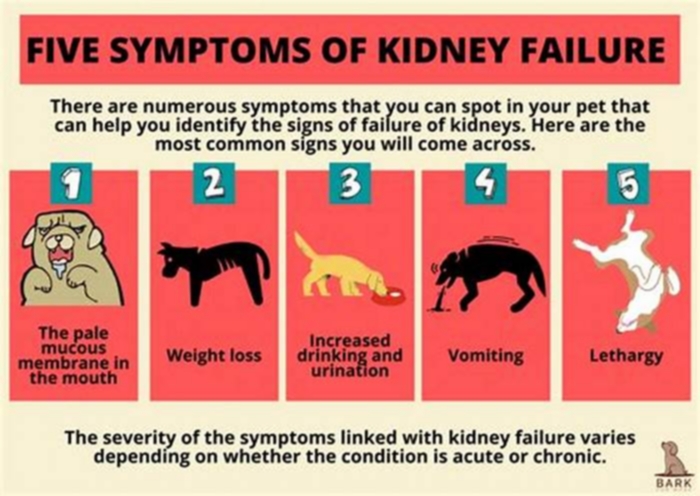
Kidney Failure In Dogs: Causes, Symptoms & Treatment Options
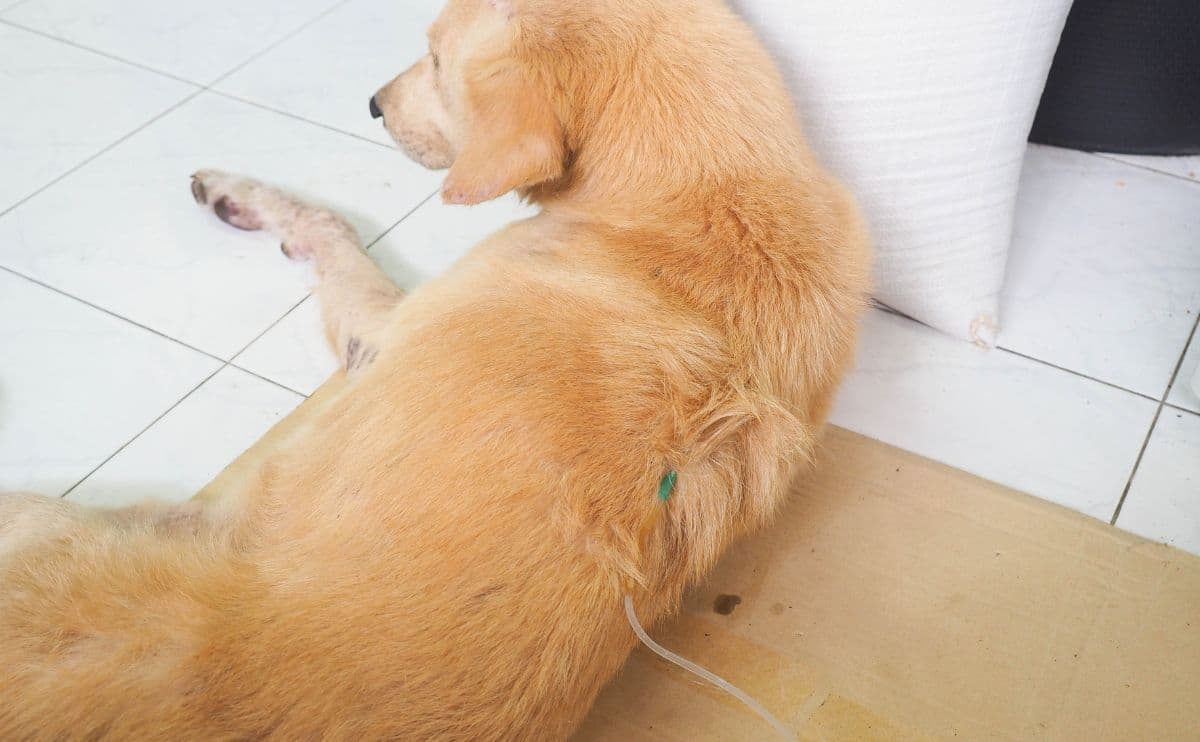
Kidney disease in dogs is a scary diagnosis for pet parents. After all, we want to spend as much time as possible with our furry family members, and the worries and concerns posed by the possibility of having to say an unexpected goodbye can take their toll. So, what is renal failure in dogs? Lets find out about the causes, the signs and symptoms, the treatment options, and how to know when its time for that final goodbye.
What Causes Kidney Failure In Dogs?
There are lots of causes of kidney failure in dogs. Toxicities from certain foods, anti-freeze, certain medications, and lilies can cause acute renal failure, even in young pets, while in some cases, the kidneys can lose their function slowly with age. Conditions like high blood pressure, cancer, bladder stones, and kidney infections can also contribute to kidney failure.
Which Foods Cause Kidney Failure In Dogs?
Grapes and raisins (and foods that contain them) can lead to kidney failure. This means that the festive period, where cookies, fruit cake, Christmas pudding, panettone, and other raisin-filled treats are everywhere, is a common time to see renal failure in dogs from toxicity.
Unfortunately, the underlying reason why grapes cause kidney damage is unknown, which means that theres no known toxic dose. Some dogs can eat grapes regularly and have no issues, while others can eat just one as a one-off with grave consequences. Therefore, its best to avoid giving your dog grapes altogether and keep them safely out of your dogs reach.
Signs Of Kidney Failure In Dogs
The signs of kidney failure in dogs are variable, depending on the stage of the disease and whether the kidney failure is acute or chronic.
Acute Kidney Failure
If your dog has acute renal failure from a toxin, obstruction, or severe infection, the symptoms are likely to come on very quickly and progress rapidly. You might notice symptoms within a couple of days of the toxicity or sooner in the case of anti-freeze. The first symptoms could be lethargy, pain, vomiting, or increased thirst. This could quickly progress to little or no urination, wobbliness, seizures, coma, or death.
Sadly, in many toxicity situations, once the kidney damage is severe enough to cause symptoms, there is far less chance of treatment being successful. Therefore, if you suspect your dog could have ingested any kind of toxin, call your veterinary clinic immediately so that appropriate measures can be taken to try to prevent any organ damage.
Chronic Kidney Failure
If your dog has chronic kidney disease, their symptoms are likely to be much more subtle and slower to develop. You might initially notice that your dog drinks more than normal or passes large volumes of urine more frequently. You might notice your pup has lost some weight, is vomiting, or hes not so interested in his food anymore. Canines with chronic kidney failure likely also seem to be subdued or lethargic.
As chronic kidney failure progresses, their thirst may become more and more excessive, but despite this, they might become dehydrated, leading to weakness and further lethargy. They may develop ulcers in their mouth, and you might notice an unpleasant smell from their mouth as the toxic waste products build up in their bloodstream. Eventually, theyll stop eating and drinking altogether, become very nauseous, and may seem painful in their abdomen.
What Causes The Symptoms Of Kidney Failure In Dogs?
The role of the kidneys within your dogs body is to control how much water leaves the body, regulate the loss of electrolytes, and remove waste products like urea from the bloodstream. In renal failure, the kidneys are no longer able to produce concentrated urine, so waste products build up in the blood. As more and more of the tiny kidney nephrons are affected, it puts more strain on the remaining parts that still work, which becomes a vicious circle.
The halitosis noted by pet owners who have dogs with chronic kidney failure is due to the build-up of these toxins and is known as a uremic smell. In some dogs, but primarily cats, small blood vessels are damaged by the urea compounds, leading to ulcers in areas like the edge of the tongue.
4 Stages Of Kidney Failure In Dogs
When it comes to the symptoms of kidney failure in dogs, stages matter. Kidney failure cases can be grouped into different stages, as formulated by the International Renal Interest Society (IRIS). The symptoms are combined with the urine concentration and blood measurements of urea, creatinine, and SDMA, which are waste products usually excreted by healthy kidneys.
In the early IRIS stages, symptoms are not apparent, whereas later, as the disease progresses, more and more symptoms appear. The IRIS stages of kidney failure in dogs illustrate the amount of kidney damage or the amount of kidney tissue that is still functional. They also aid veterinarians in determining the best treatment and management options.
Dog Kidney Failure Stages Chart
You can see the stages of chronic kidney disease in dogs in the following graphic:
| Stage | Creatinine | SDMA | Urine | Symptoms |
|---|---|---|---|---|
| I | Normal | Normal or slightly raised | May be inadequate concentration, may contain protein | None |
| II | Normal or mildly increased | Mildly raised | Inadequate concentration, may contain protein | None or very mild |
| III | Moderately increased | Moderately raised | Inadequate concentration, may contain protein | Often drinking and urinating more, may be more severe symptoms |
| IV | Markedly increased | Markedly raised | Inadequate concentration, protein likely | Weight loss, vomiting, reduced appetite, drinking and urinating more |
How To Treat Kidney Failure In Dogs
Unfortunately, when a kidney tubule (or nephron) stops working, it cant be fixed. However, treatment and good management can help to slow down the progression of kidney disease and support the remaining functional nephrons. Dogs who are still eating well and arent vomiting may only require a prescription kidney diet.
If their phosphate levels are high, a phosphate binder medication will also help by preventing the absorption of phosphate from their food. If your dog is still in the early stages of chronic kidney disease but isnt eating well or is nauseous, an anti-emetic medication may also be used.
Finally, if your dog has late stage III or stage IV kidney disease, theyll probably need to stay in the hospital for a fluid drip to flush the waste products out of the body and lower the urea and creatinine levels. Unfortunately, this improvement will only be temporary, and over time, the levels will increase once again.
When To Euthanize?
Whenever youre dealing with a chronic health issue in your dog, its really difficult to know when to make the sad decision to euthanize them. After all, theyre likely to have good and bad days, and it might feel like they get a little bit better just when you are about to make the call. The most important thing is to consider your dogs quality of life whether theyre eating, mobile, or showing any signs of pain.
If theyre struggling in more than one of those areas, despite veterinary treatment, its likely to be time to say goodbye. Its also worth looking back over the last two weeks to see how many good and bad days theyve had. If the bad days outweigh the good, euthanasia is the kindest option for your canine companion.

Frequently Asked Questions
Here are some common questions about dogs with kidney issues. Dont see yours here? Ask us in our comments.
Does pet insurance cover kidney disease in dogs?
Yes, pet insurance covers kidney disease in dogsas long as no signs or symptoms appear until after policy enrollment and waiting periods have passed.
What happens in the last days of a dog with kidney failure?
In the last days of a dog with kidney failure, theyre likely to stop eating or drinking altogether. They may be weak and wobbly from dehydration, and their other organs may start to fail. If you notice that your dog with kidney failure is deteriorating, you should contact your vet as soon as possible.
Is kidney failure in dogs painful?
Acute kidney failure, due to causes like toxins, infections, or bladder stones, can be very painful and requires emergency assessment by a veterinarian. Chronic renal failure is unlikely to be painful initially, but in the more severe stages of the disease, your dog may feel nauseous, disorientated, or painful.
What is the cost of treating kidney failure in dogs?
The cost of treating kidney failure will vary depending on your location and the type of treatment your dog needs. The most costly would be a fluid drip and hospitalization, but ongoing prescription diets and phosphate binders can also add up in the long term.
How long can a dog live with kidney failure?
The length of time that a dog can live with kidney failure will depend on the stage when the diagnosis was made. If caught early, chronic kidney failure can be managed for several years in some cases. However, if the disease is already advanced or management guidelines arent followed, a dogs quality of life may suffer within a few weeks or months.
What level of creatinine indicates kidney failure in dogs?
A dogs creatinine level should always be evaluated alongside a urine sample. If the urine sample shows poor concentration and the creatinine level is raised, this indicates that the kidneys are not functioning effectively.
Understanding Dogs Health
Kidney disease in dogs is a complex subject, and if the diagnosis is made early, even before your dog shows symptoms, the prognosis is much more favorable. Therefore, it may be a good idea to consider routine blood tests once your dog is older than seven or eight, and you should keep a close eye out for possible symptoms. You might consider an at-home urine test, that can help detect things like kidney stones and urinary tract infections in dogs.
Tagged With:10 Common Causes of Kidney Disease in Dogs
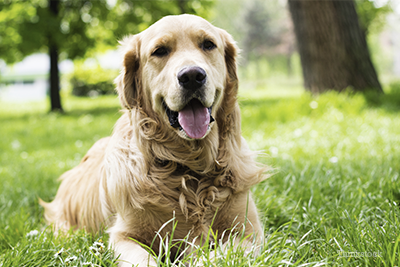
Kidney disease is a common problem of older dogs, affecting an estimated 10% of canines in their lifetimes1. There are a number of causes that may affect different age groups and have different consequences, ultimately though, chronic kidney disease (occurs over time) or acute kidney injury(occurs suddenly) will always have the same resultone sick pup. The signs of illness in your dog reflect the failure of the kidneys to do their many jobs well enough.Learn the basics of chronic kidney disease in dogs.Below you will find a brief description of ten common causes of kidney disease. These are the targets of your veterinarians testing:1. Damage to the kidney filters (glomerular disease)The glomerulus of the kidney (kidney filtration mechanism) is commonly involved in canine kidney disease. Early on, we expect no signs of illness, but since glomerular disease may be caused by infections (like Lyme disease) or cancer, amongst other things, time can make the problems worse. Over time, inflammation, in the glomerulus of the kidney, damages the surrounding kidney tissues, creating the chronic kidney disease that makes your dog feel sick.
Learn more about glomerular disease in dogs.
2. Infection of kidney tissues (pyelonephritis)Infection of kidney tissues with bacteria, or rarely, fungal organisms, is one of the kidney diseases that may have a more favorable outcome, so your veterinarian will be on the lookout for it. Our goal with pyelonephritis is to kill the bacteria that can cause the damaging inflammation. This should limit progression of any chronic kidney disease or assist with recovery from an acute kidney injury. A bacterial urine culture and susceptibility can verify the infection and identify which antibiotic might work the best.3. Kidney stones (nephrolithiasis)Kidney stones can be the product of chronic bacterial infection, genetics or diseases that alter blood or urine characteristics. Nephro (kidney) liths (stones) dont seem to cause dogs much pain, but this can change if they cause blockage within the kidney or its collecting ducts; it can also change if they contribute to infection (see pyelonephritis).
Learn more about kidney stones in dogs.4. Kidney blockage (ureteral obstruction with hydronephrosis)Kidney stones can fragment and be carried along with urine into the ureter, the long narrow tube that connects each kidney to the urinary bladder. They are probably painful during their transit, but the bigger concern is the consequence to the kidney if they become lodged there, causing partial or complete blockage. New urine cannot exit the kidney easily and it backs up, causing the kidneys to swell. With enough pressure, the kidneys enlarge (hydronephrosis) and become damaged. If both ureters obstruct at the same time, it can prove disastrous.
5. Damage to kidney tubules (tubulointerstitial disease)Inflammation and damage to the kidney tubules and supporting tissues commonly leads to chronic kidney disease. In many cases there is no identified cause, and thus no option for specific treatment. This type of kidney disease can only be confirmed by microscopic examination of a kidney biopsy specimen, but biopsies are not usually recommended.6. Bacterial infection (leptospirosis)Bacterial infection with leptospires causes kidney disease and other organ challenges in dogs and people all over the world. Normally, the effects of leptospirosis will be quite sudden and cause an acute kidney injury. Occasionally, the infection might cause chronic kidney disease. Quick recognition of this highly treatable disease should lead to a better outcome and protect your dogs friends and family (YOU!) from becoming infected by contact with urine or other body fluids.
Learn more about leptospirosis in dogs.
7. ToxinsLots of household items can damage the kidneys, not just antifreeze. Ordinary table foods like grapes and raisins; certain commercial jerky treat products; common OTC medications like aspirin or other nonsteroidals (NSAIDs); or prescribed medications can all cause kidney disease. Venoms, pesticides and heavy metals are less common toxins. We know dogs like to lick stuff, eat stuff, roll in stuff or bathe in stuff, but that can put them at real risk. To reduce your buddys risk of kidney injury, consider limiting his free-roaming behaviors and refrain from giving him any medications without discussing it first with your veterinarian.
See the top 5 most damaging kidney toxins for dogs.
If you have any reason to believe your dog has been poisoned, contact your veterinarian or an emergency veterinarian right away. You may also contact:
8. CancerFortunately, kidney cancer is not very common in dogs. Unfortunately, treatment options for kidney cancer are rather limited. Solitary tumors affecting only one kidney can be removed by surgery with a good outcome, if the cancer is benign or has not spread to other parts of the body (including the opposite kidney). Your dog only needs one good kidney to function normally. If the cancer is more widespread, as usually occurs with lymphosarcoma, surgery will not be an option for cure. Microscopic analysis of a biopsy or small needle sample is needed for the correct diagnosis of cancer and appropriate treatment plans.
Learn 10 signs of cancer in dogs.
9. Protein issue (amyloidosis)Patients with amyloidosis lose function in certain organs, including the kidneys, because protein deposits replace the normal tissue. It is an uncommon consequence of chronic inflammation affecting other parts of the body. It may also be genetically programmed in some dog breeds. Amyloid deposits cannot be cleared away, and the functional kidney tissue that is lost cannot be replaced, so the prognosis is not good.
Learn more about amyloidosis in dogs.
10. Hereditary There are genetic links to various kinds of kidney disease for many purebred dogs. Some young dogs fail to develop normal kidneys, or have kidneys that are large and grape-like, with many fluid- filled cysts. These dogs show signs of kidney disease as youngsters. Other dogs with congenital problems of the glomerulus or with a predisposition to amyloidosis might only show signs or symptoms of kidney disease when theyre adults.
If you have any questions or concerns, you should always visit or call your veterinarian -- they are your best resource to ensure the health and well-being of your pets.References:
- Brown SA. Renal dysfunction in small animals. The Merck Veterinary Manual website. Updated October 2013. Accessed January 14, 2015.


